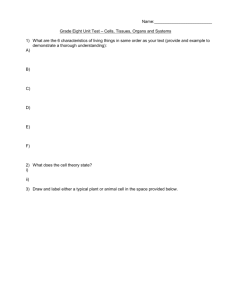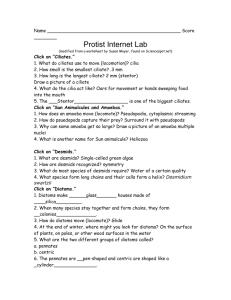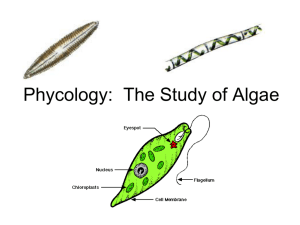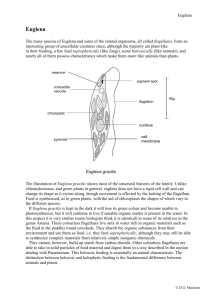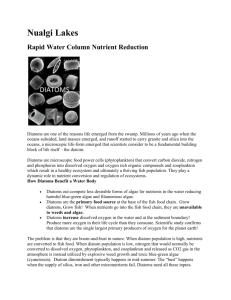Biol-302 Botany, Winter 2007
advertisement
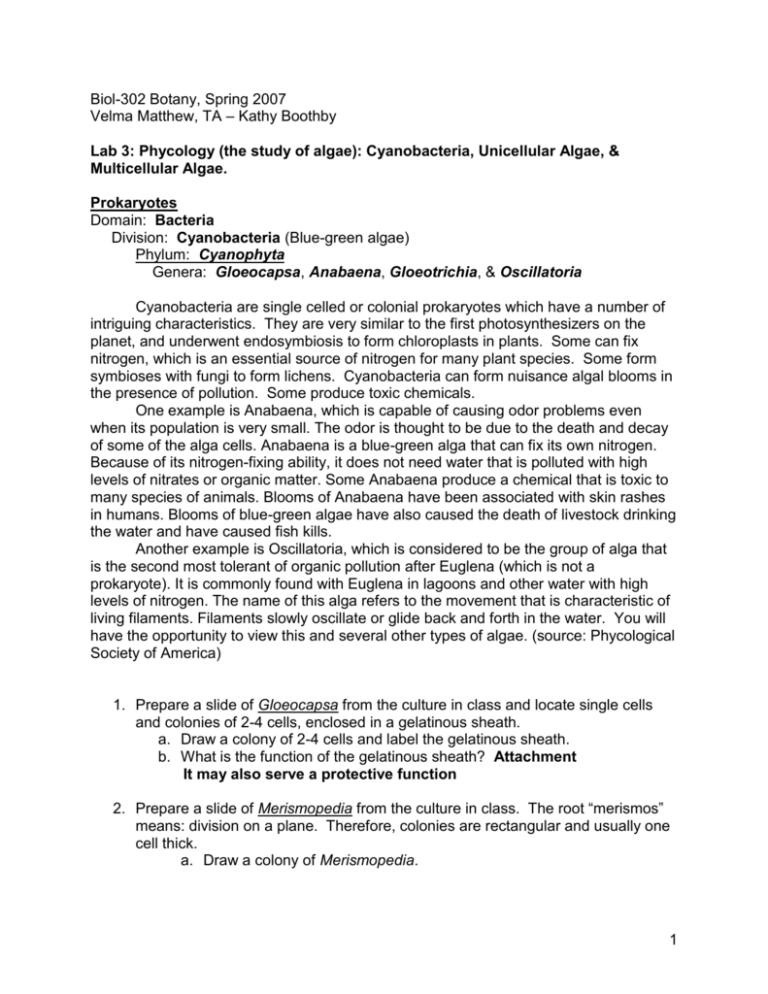
Biol-302 Botany, Spring 2007 Velma Matthew, TA – Kathy Boothby Lab 3: Phycology (the study of algae): Cyanobacteria, Unicellular Algae, & Multicellular Algae. Prokaryotes Domain: Bacteria Division: Cyanobacteria (Blue-green algae) Phylum: Cyanophyta Genera: Gloeocapsa, Anabaena, Gloeotrichia, & Oscillatoria Cyanobacteria are single celled or colonial prokaryotes which have a number of intriguing characteristics. They are very similar to the first photosynthesizers on the planet, and underwent endosymbiosis to form chloroplasts in plants. Some can fix nitrogen, which is an essential source of nitrogen for many plant species. Some form symbioses with fungi to form lichens. Cyanobacteria can form nuisance algal blooms in the presence of pollution. Some produce toxic chemicals. One example is Anabaena, which is capable of causing odor problems even when its population is very small. The odor is thought to be due to the death and decay of some of the alga cells. Anabaena is a blue-green alga that can fix its own nitrogen. Because of its nitrogen-fixing ability, it does not need water that is polluted with high levels of nitrates or organic matter. Some Anabaena produce a chemical that is toxic to many species of animals. Blooms of Anabaena have been associated with skin rashes in humans. Blooms of blue-green algae have also caused the death of livestock drinking the water and have caused fish kills. Another example is Oscillatoria, which is considered to be the group of alga that is the second most tolerant of organic pollution after Euglena (which is not a prokaryote). It is commonly found with Euglena in lagoons and other water with high levels of nitrogen. The name of this alga refers to the movement that is characteristic of living filaments. Filaments slowly oscillate or glide back and forth in the water. You will have the opportunity to view this and several other types of algae. (source: Phycological Society of America) 1. Prepare a slide of Gloeocapsa from the culture in class and locate single cells and colonies of 2-4 cells, enclosed in a gelatinous sheath. a. Draw a colony of 2-4 cells and label the gelatinous sheath. b. What is the function of the gelatinous sheath? Attachment It may also serve a protective function 2. Prepare a slide of Merismopedia from the culture in class. The root “merismos” means: division on a plane. Therefore, colonies are rectangular and usually one cell thick. a. Draw a colony of Merismopedia. 1 3. Prepare a slide of Anabaena from the culture in class. These filamentous bacteria have heterocysts, akinetes, & photosynthetic cells. a. Draw a filament of Anabaena and label the three structures mentioned above & the gelatinous matrix. b. What is the function of heterocysts and why must they be kept separate from the photosynthetic cells? Nitrogen fixing Nitrogenase, the enzyme that catalyses the reaction, is sensitive to oxygen. It only works in an anaerobic environment. 4. Prepare a slide of Gloeothrichia from the culture in class. a. Draw and label the heterocysts, akinetes, photosynthetic cells, & the gelatinous matrix. b. What is the function of an akinete? Survival during harsh conditions 5. Prepare a slide of Oscillatoria from the culture in class. The cells of these filamentous bacteria are joined only at their walls, so that each cell leads an independent life. a. Draw a filament of Oscillatoria and label the individual cells. b. Are any of the filaments divided in to short fragments or segments? (segments are differentiated by dark dead cells) These fragments are called hormogonia (singular: hormogonium); what is the purpose of the fragments? Produce new filament after it breaks free from the main filament Eukaryotes Kingdom: Protista Phylum: Euglenophyta Genus: Euglena Many authorities consider Euglena as the most tolerant genus of organic pollution. It is commonly found in farm ponds, lagoons where sewage is treated, and other bodies of water with high levels of nitrogen (though Euglena will also be found in clean water). Sometimes a red pigment hides the chlorophyll (Phycological Society of America), and can turn the water red. 6. Prepare a slide of Euglena from the culture in class. Euglena are unicellular organisms that contain chloroplast similar to those of green algae; this suggest that the euglenoid chloroplast were derived from endosymbiotic green algae. a. Draw a Euglena and label the flagellum, eye spot (stigma), contractile vacuole, nucleus, and a chloroplast. What is the color of the stigma? What is its function? In what direction are the Euglena moving (flagellum end or other end)? Function of the eyespot: It shades the actual photoreceptor as the Euglena swims. 2 Eukaryotes Kingdom: Protista Phylum: Bacillariophyta Family: Bacillariophyceae (Diatoms) Diatoms, such as Navicula, are often used as indicators of water quality. Clean water has relatively low populations of many different species of diatoms. As water becomes polluted, the variety of diatoms decreases, but the population of pollution tolerant types increases. The silica cell walls of diatoms do not decompose when the cells die. The remaining skeletons of the cells leave a long fossil record, but can create problems when they clog the filters at water treatment plants, especially during the spring and fall when diatoms are most abundant (they prefer cold water). The diatoms are killed by chlorine, which is added to the water as it enters the treatment plant. The silica boxes do not break down and must be filtered out of the water. Diatomaceous earth is composed of the fossilized shells of diatoms. It is found in areas (such as the Great Basin) that were once covered by oceans but are now dry. Diatomaceous earth is used by organic gardeners to control insects around plants. The tiny holes in the silica material absorb moisture, which kills the insects. 7. Look at a prepared slide of Diatoms. Several species may be present on each slide. Note that some diatoms aggregate into filaments, while others do not. a. Draw both pennate and centric diatoms. 8. Prepare a slide of Navicula from the culture in class. a. Draw Navicula. b. Is this pennate or centric? 9. Prepare a slide of diatomaceous earth from the sample in class. a. Draw the diatoms that you see. b. Are these pennate or centric diatoms? 3
